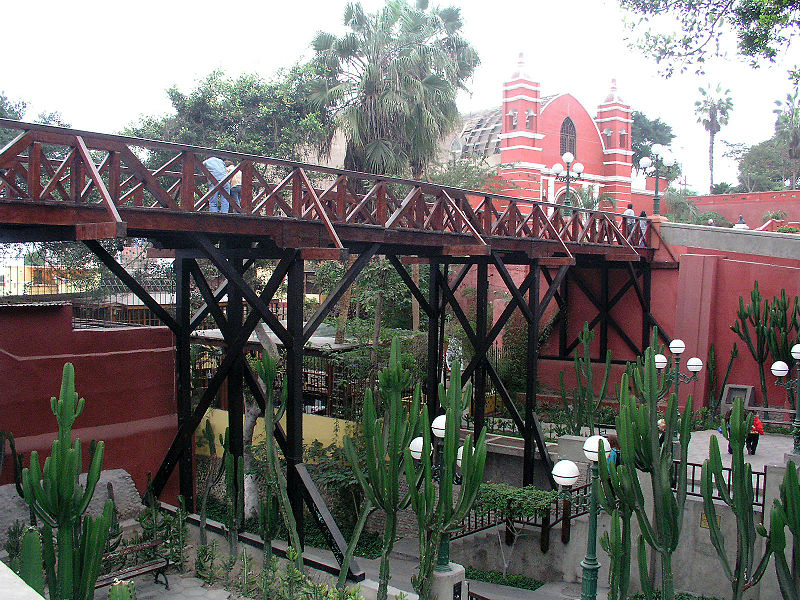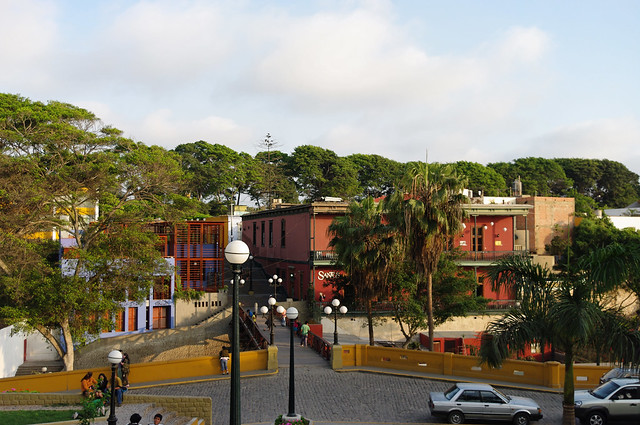At first glance, you might not even feel you're in Peru’s capital – Barranco has a different flavour from, say, the historic centre or modern Miraflores. This petite district ending on a cliff overlooking the Pacific Ocean was once a separate little fishing village and is today a magnet for limeños (locals) looking to play thanks to its beaches, its pubs and restaurants, and its lively, creative vibe and romantic architecture – the latter a remnant of the late 19th and early 20th centuries when the Lima‘s upper classes built their fancy and very European-style summer houses out here, the former a product of the young-trending creatives and hipsters who help make Barranco what it is today.
The central and eponymous feature of Barranco is the barranco itself – that’s Spanish for ravine or gully, crossed at one point by a Puente de los Suspiros (Bridge of Sighs, top); they say if you cross it for the first time while holding your breath and make a wish, that wish will come true.
Apart from the splashing around at beaches like Barranquito, Los Yuyos, La Cascada, and Los Pavos – which among other things attract their fair share of surfers – on the streets themselves it’s mostly laid back around here by day. Stroll through the pretty little Plazuela Villarreal (1926) and make your way to the Bajada de los Baños, the sloping walkway down to the beachfront, flanked by vegetation and pretty, rustic houses. There are plenty of other parks around here, too, such as the Parque Municipal Barranco (1898) with its palms and particularly known for its statue of Venus (aka La Danaide), as well as the much newer (1992) Parque de Chabuca Granda, dedicated to a famous Barranco-born singer and composer of the 1940s, 50s, and 60s. Along the way, perambulators will come across the strikingly red Iglesia de la Ermita (Hermitage Church), built by local fishermen in the 18th century, so the story goes, to give thanks for rescue in a storm.
Pressing onward, with pit stops along the way at cafés for refreshment from regular java or the national soft drink Inca Kola (think carbonated liquid bubble gum, coloured bright yellow) to something stronger like a pisco sour or other tipple made from Peru’s classic grape brandy, Barranco has plenty of art galleries to offer, such as Lucía de La Puente and Wu Galería. The shoppers on the younger side (or young at heart) head for shops like Dédalo, with threads and quirky objets, along with a café of its own, as well as the Centro Colich, a 1907 manse the local art and design mecca with an even wider variety of the same – definitely a cultural hotspot hereabouts.
Speaking of which, culture vultures will definitely also not want to miss a pair of classic local institutions, the Museo Pedro de Osma, displaying Peruvian art from the 16th through 19th centuries, and the MAC (Contemporary Art Museum), covering Peruvian, Latin American, and some European artists from the 1950s onward. There’s also a cool little Electricity Museum around here that kids of all ages will get a, well, charge out of.
Sightseeing and shopping over, it’s time for dining, drinking, and partying. And this is the time when the area seems to especially perk up, as folks flock to Barranco restaurants like Canta Rana on Calle Génova 10 (considered by some to serve the city’s best ceviche) and Chifa Chung Yion at Calle Unión 126 (similarly considered to be one of its best chifas, meaning Chinese-Peruvian mix).
Afterward, you’ll find that nightlife is varied (though tending more to the intimate side), but one of the most authentic musts is attending a peña criolla, which features a kind of traditional (some of the more tourist oriented also include folkloric performances from elsewhere in Peru; top choices include Peña del Carajo, Peña de Rompe y Raja, Peña Poggi). If you’re still up for more nightlife after that, head to Boulevard Sánchez Carrión, full of nightspots and party people; one of the top mainstays here is La Noche, with a lineup of live music from jazz to rock to flamenco (though that’s far from the only area in Barranco to make a night of it; not far away, off main drag Avenida Grau, is a particularly fashionable spot called Ayahuasca, a bar/restaraunt in a big, gorgeous 19th-century manse with eclectic, sometimes delightfully kitsch décor. Stop in, have a delicious pisco sour, and tell them Iberia sent you.
Useful Facts
Lima has a population of more than 8 million.
The area has a mild desert climate without major fluctuations in temperature throughout the year (they rarely drop much below 12 °Celsius/54 °Fahrenheit or rise above 29°C /84 °F).
The currency is the Nuevo Sol.
More information: BarrancoPeru.com, VisitLima.pe, LimaEasy.com.
Best Iberia fares from the UK, from Spain.
Foto | Xauxa,



Comments